But not too many people know that poor dental hygiene can lead to a host of other more serious illnesses.
Table of Contents
Take, for example, this 2010 New York University (NYU) study that links gum inflammation and Alzheimer’s Disease.
Study participants were nine times more likely to have a score in the lower range of the cognitive test – the “digit symbol test” (DST) – if they had inflammation of the gums.
Or how about a 2007 study from the Harvard School of Public Health that reported strong evidence linking gum disease with pancreatic cancer.
Harvard researchers found that men with a history of gum disease had a 64% increased risk of pancreatic cancer compared with men who never had gum disease.
And perhaps more well established is the association between dental hygiene and heart disease.
In 2008, Medical News Today reported on research from joint teams at the University of Bristol in the UK and the Royal College of Surgeons in Dublin, Ireland, who found that people with bleeding gums from poor dental hygiene could be increasing their risk of heart disease.
And that’s just the tip of the iceberg. A patient’s teeth gives you a window into so many potential health issues including:
- Anxiety or poor sleep. Stress, anxiety, and sleep disorder can cause teeth grinding. Bruxism is significantly more frequent in people with sleep apnea.
- Eating disorders. Certain disorders, such as anorexia or bulimia, can be apparent to a dentist.
- Alcohol abuse. Brazilian researchers discovered that gum disease increased with drinking frequency.
As a professional in this field, you likely know all this. It’s your job to.
But your patients are all too often left in the dark. And that not only hurts your ability to keep your patients healthy, but it prevents them from realizing just how important a role you play in their wellbeing.
Of course, it doesn’t have to be that way. Through clever and targeted dental marketing tactics, you can help your patients and prospects understand how a simple visit to the dentist, twice a year, can quite literally save their life.
Using targeted messaging based on results of dental visits
How do you notify your patients about upcoming dentist appointments? Is it through email? A text message? Phone call?
All of the above?
The reason we ask is, because, clearly you have you direct contact information for your patients. That’s standard operating procedure.
What if you could use that contact information to provide targeted, useful, information to your patients?
You can.
It doesn’t take much at all to automate a process where you trigger messages to your patients based on the results of their dental visits.
Let’s use an example.
You have a 35-year-old patient named Sharon who has a history of gum disease and poor dental habits. This is now her third straight visit where you record concerns over her gum health.
Your automated system triggers a message to her, based on this being the third time you’ve recorded such a concern.
That message comes in a form of a personalized email, from you (although you’ve written it long ago as a template). In it you call her by name and say something like this:
“Hey Sharon,
I wanted to reach out to you by email today in response to your latest visit. I’ve grown concerned about your oral health, and how it might begin to impact your overall health.
Did you know that gum disease is linked to such ailments as heart disease and Alzheimer’s?
My team and I created an entire resource center around this issue. If you get a chance, take a look at it and consider scheduling a call with your primary doctor to discuss my concerns.
And please, don’t hesitate to call my office with any questions you might have.”
In this email we reference a “resource center.” This resource center could be, essentially, a blog on your website. See the image here from a Tacoma, WA-based dentist:
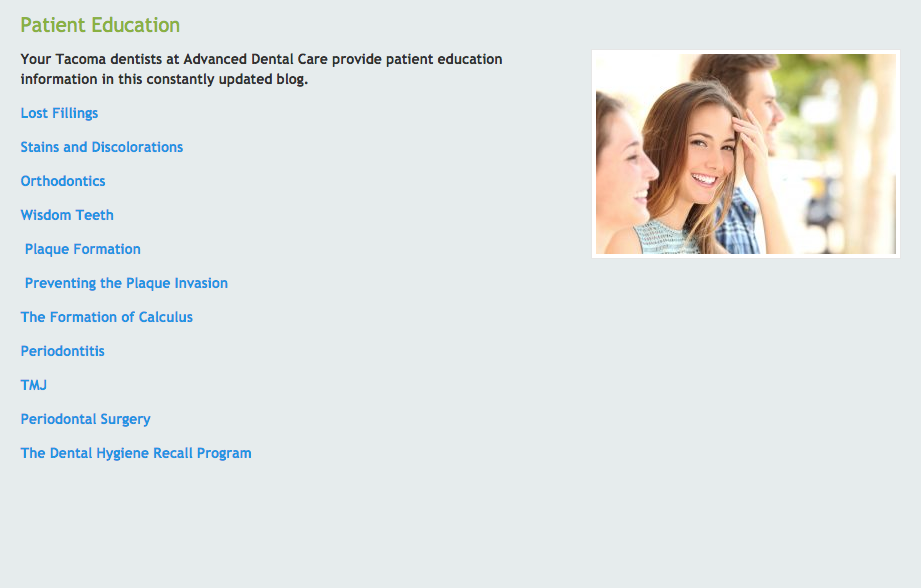
The link you provide to Sharon would take her directly to a category specific to gum disease, for example. This resource center can, and should be used, in many ways with your marketing, as you’ll see as you continue to read this article.
What this simple, and automated email, does is show your patients how much you care, and provides them with a useful resource on your website. This, in turn, strengthens their trust in you, and allows you to play a bigger role in their overall health.
Newsletters
This same approach could be used if you send out monthly or periodic newsletters. Often, dentists shoot out the same newsletter to their entire patient database.
But the most effective way to reach an audience is to personalize their messaging. By personalizing we don’t mean using their names. Sure, that’s great, too. By personalizing we mean tailoring entire messages based on the unique needs of your audience.
In other words, patients like Sharon would receive a newsletter tailored specific to gum disease prevention. Whereas, patients who have expressed an interest in teeth whitening, for example, would receive an entirely different newsletter.
It sounds more complicated than it is. Using a mailing system like MailChimp (free based on how many contacts you have) you can segment your contacts into different groups. You could have one main list for “current patients”, and then lists for “Patients with Gum Disease” and “Patients Who Want Teeth Whitening” and so on.
In fact, we here at Cardinal have been known to automate the whole process so that, based on what your team enters in your database following a visit, we could send that information to your email marketing provider (like MailChimp) so that your lists are always accurate.
Without you doing a single thing.
Social media advertising
The other way you can reach out to your patients, based on the results of their visits, is through social media advertising. You can do this on Facebook, thanks to the contact information you have on your patients.
When you create an ad in Facebook, you have the ability to create a custom audience to target that ad to.
One of the ways you can create a targeted audience is through what Facebook calls a “customer file.”
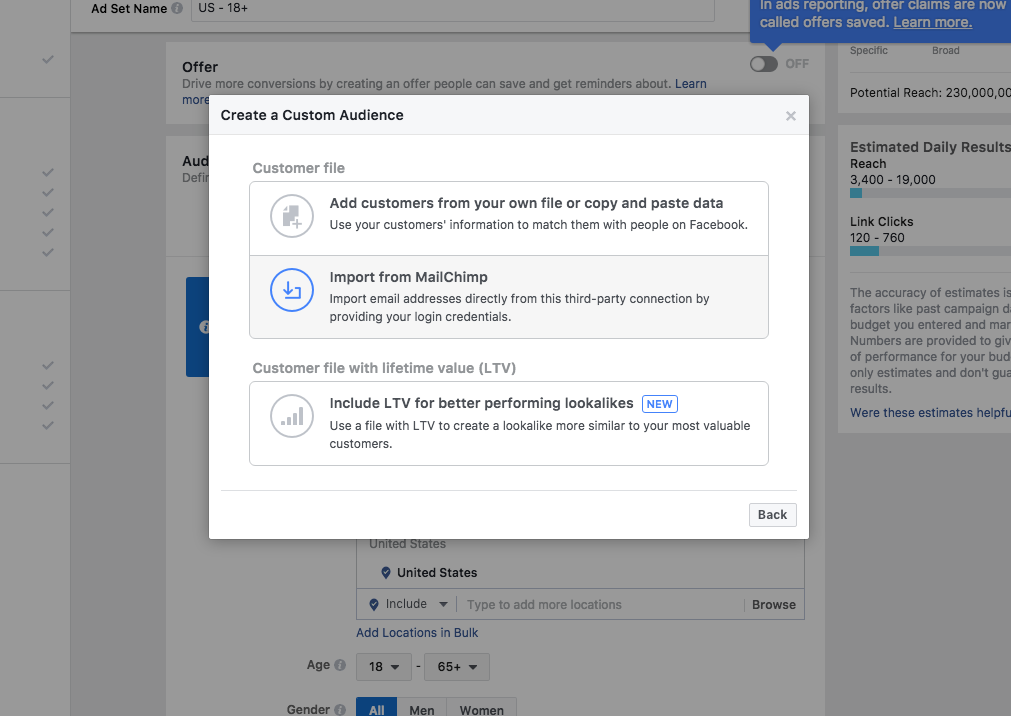
As you see in the image above, you can upload your own file or, if you use MailChimp, you can import your contacts directly from your account.
This allows you to create highly personalized ads that reach only the people you want them to reach. Keep in mind, we’re not referring to “Boosted Posts.” Those types of posts show up on your feed first, and then you promote them. We’re focused on ads, meaning posts that never show up on your business page. They only show up in the feeds of people you want to target.
So, what do you put in these ads that you’re targeting toward specific patients?
Well, for folks like Sharon, you can use the gum disease resources you’ve created in your “resource center” (remember that?).
These could be articles, videos, infographics and more. For example, let’s say that you have an article in your resource center titled: “10 ways to fight gum disease from the comfort of your home.”
You could create an ad that promotes that article, and target it to folks, like Sharon, who your records indicate suffer from gum disease.
Based on conversations she’s likely already had with you, these ads will hit home with her.
How to reach out to newer prospects
Until now we’ve discussed ways for you to connect with your existing patients. Don’t overlook those tips. A key part of marketing is delighting your existing base. By providing invaluable, relevant content to your patients, you’re proving your worth to them and increasing the chances that they’ll:
- Be more involved in their heath regimen
- Turn to you for concerns with their oral health
In other words, this type of digital marketing services takes you from the person your patients see two times a year, to someone wholly invested in their wellbeing.
But good healthcare marketing also helps you reach out to new prospects as well. So, how do you go about reaching out to new prospects?
That’s exactly what we’ll discuss now. Keep in mind, that resource center we suggested you create a while back? Yeah, that’s going to, yet again, be a key component of turning strangers into patients.
Let’s get started.
Advertising to new prospects on social media
As a dentist, when you provide quality online content to your patients, chances are they’ll follow you on social media platforms like Facebook.
That’s a key component in trying to woo new audiences your way. Here’s why. Check out this ad by Delta:

We’ve blurred out the names at the top of the image; however, what it shows you is that friends in our circle like Delta. That’s standard in Facebook ads; it’ll show you if your friends like that page.
Now, if this ad were from a smaller, local, dentist, such as your practice, then seeing that some of our friends like your page might give us enough reason to learn more about you. Especially if the ad promoted some type of useful information from your (wait for it ..) resource center.
That’s why we strongly encourage you to keep your page active, and find ways to engage with your current patients on, and off, line.
But the question remains, how do you reach newer audience?
With Facebook there are endless possibilities.
When creating ad, you can create a custom audience. By choosing that option, this will show up on your screen:
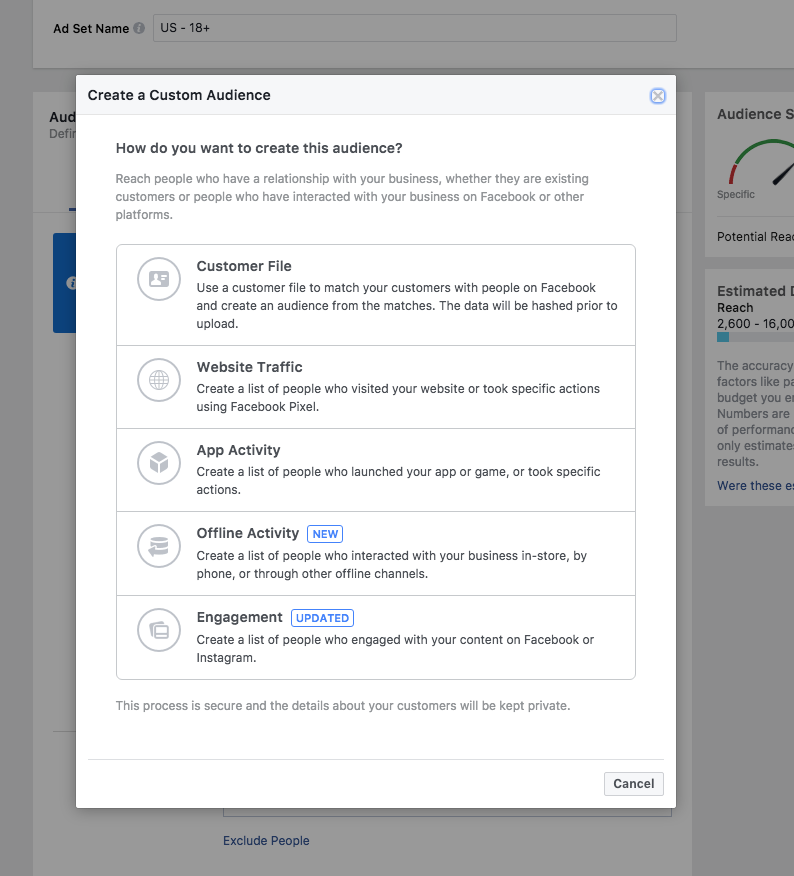
As you can see, there are several ways to reach audiences beyond the folks who already like your page.
We’ve mentioned “Customer File” earlier in this article. But there are other options as well, including targeting folks who have visited your website or who you’ve interacted with offline.
Depending on which custom audience you use, you’ll want to target your ads accordingly.
For example, if you choose “Website Traffic” (meaning you’ve set up a Facebook Pixel on your site) then your ad should be related to the page they visited on your website.
For example, if you were to set up a pixel on a page similar to this:
![]()
Then you can create a Facebook ad, about, for example, root planing, and target folks on Facebook who visited this webpage. It’s a clever way to continue the conversation with your web visitors.
You don’t have to use one of those custom audience options above, however. When creating a new audience, you can choose “Lookalike Audience” instead:
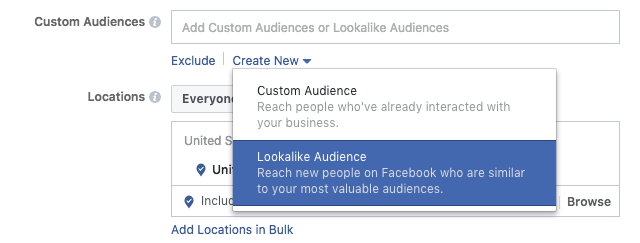
When you click on that option, you’ll be taken to this screen:
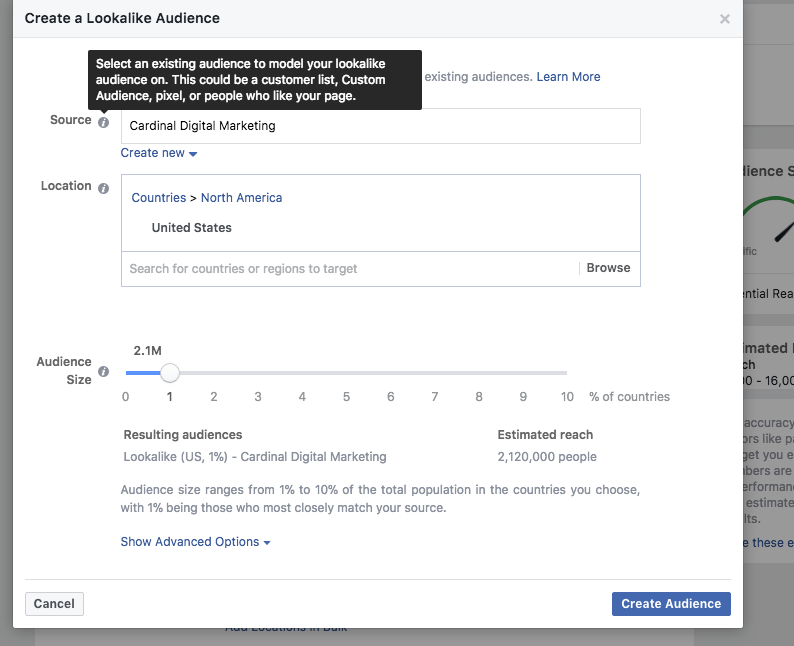
In the image above we’ve added “Cardinal Digital Marketing” as the source. But there are a number of audience segments you can choose. Basically, what Facebook does is target your ad to people who share common traits and interests as whatever source you choose. For our example, our ad would target folks similar to our page followers; however, not our followers exactly.
That way, we can reach people in our target location who would very likely be interested in what we have to offer.
You can do the same with your page. Create a lookalike audience based on your existing followers (again, yet another reason why it’s important to get your patients to follow you on Facebook).
That way whatever ads you create on Facebook, you know you’re targeting people who are interested in what you have to say.
Just remember, there’s a special way to approach Facebook ads. These ads aren’t like standard healthcare PPC ads, Folks go to Facebook for an entirely different reason then why they go to Google.
In fact, we wrote an entire article to help people understand how to approach Facebook ads vs PPC ads >>
Target the right people with a powerful message – minus the marketing jargon
Whether you reach out to current or new patients, make sure to create relevant messages to your audiences.
If you had a conversation with a patient about cavities, that should be the subject of a message you target to them, either via an ad, email, or any other way.
And rather than try to fill your messaging or ad with marketing lingo, be transparent. Stick to your role as healthcare provider. Offer useful information to your audiences. You’ll be surprised just how many people will use that information as a reason to become a lifelong, and happy, patient.

